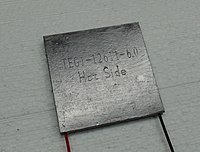
Photo from wikipedia
Organic semiconductor (OSC) thermoelectric materials have been studied widely for their low thermal conductivity and solution processing characteristics. Currently, the high conductivity (up to 1000s cm -1 ) has boosted… Click to show full abstract
Organic semiconductor (OSC) thermoelectric materials have been studied widely for their low thermal conductivity and solution processing characteristics. Currently, the high conductivity (up to 1000s cm -1 ) has boosted the performance of p-type organic thermoelectric materials substantially. Whereas, the development of n-type organic thermoelectric materials still limited severely by their low Organic semiconductor (OSCs) thermoelectric materials have been studied widely due to their low thermal conductivity and solution processing characteristics. Currently, the high conductivity (up to 1000s cm -1 ) has boosted the performance of p-type organic thermoelectric materials substantially. Whereas, the development of n-type organic thermoelectric materials is still limited by their low mobility, inferior air stability and poor doping efficiency, which is relevant to the molecule structure and dopant dispersion tightly. Herein, the recent development of n-type organic thermoelectric materials is reviewed with an emphasis on molecule structure modification and solution processing. Methods for optimizing conjugate structure are summarized from the effects of conjugated backbone modification and side chains diversification on molecular stacking. The primary n-type dopants are also summarized briefly. Especially, the role of solution aggregation controlling on film preparation and properties is endowed with special attention. Additionally, the emergence of organic diradicals with low LUMO energy level and no doping is introduced, which shows great potential in n-type organic thermoelectric materials. All the endeavors have led to the development of n-type OSCs materials. This paper is aimed at illustrating the state-of-the-art progress nowadays and providing some guideline for the design of organic thermoelectric materials in the future. mobility, low air stability and low doping efficiency, which was related to the molecule structure and dopant dispersion tightly. Herein, the recent development of n-type organic thermoelectric materials was reviewed with an emphasis on molecule structure modification and solution processing. Methods for optimizing conjugate structure are summarized from the effects of conjugated backbone modification and side chains diversification on molecular stacking. The primary dopants which are suitable for n-type materials also summarized briefly. Especially, the role of solution aggregation controlling on film preparation and properties is endowed with special attention. Additionally, the emerge of organic diradicals with low LUMO energy level and no doping is introduced, which shows great potential in n-type organic thermoelectric materials. All the endeavors have facilitated the development of n-type materials keep moving forward. This paper aimed to illustrate the state-of-the-art progress nowadays and provide some guideline for the design of organic thermoelectric materials in the future.
Journal Title: ChemSusChem
Year Published: 2021
Link to full text (if available)
Share on Social Media: Sign Up to like & get
recommendations!